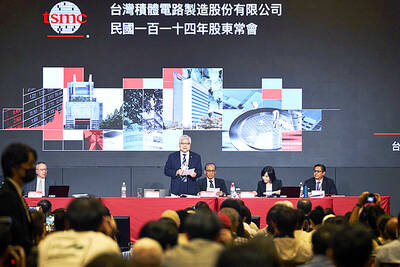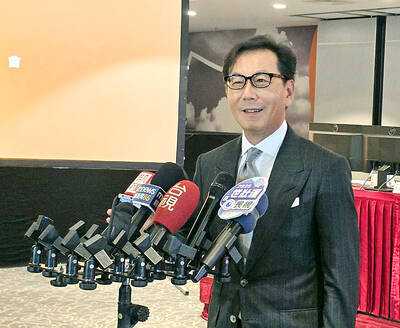Inventec Corp (英業達) chairman Richard Lee (李詩欽) yesterday confirmed the company is making Xiaomi Inc’s (小米) first notebook computer product in China, with shipments set to begin in the first half of next year.
“I am upbeat about the business outlook for Xiaomi’s notebook computers, as the firm has more than 200 million registered smartphone users,” Lee told reporters on the sidelines of the 12th cross-strait forum on technical standards for information technology held in New Taipei City.
Lee said Xiaomi is likely to adopt the same smartphone business strategy for its laptop products — which is different from other companies’ conventional way of selling servers, desktop and notebook computers.
“I am not sure if the smartphone approach will be applicable to notebooks, but I expect Xiaomi’s entry into the notebook industry to bring something new to the market,” Lee said.
Subsidiary Inventec Appliance Corp (英華達), which assembles Xiaomi’s smartphones, is to jointly design and manufacture the Chinese company’s first notebook products in Inventec’s plants in China, Lee said.
“We will start shipping Xiaomi’s notebook computers in the first or second quarter of next year,” he added.
Commenting on Inventec’s near-term business outlook, Lee said next quarter’s sales are likely to be flat or even decline from this quarter, because of few product launches by its clients.
“Given that some of Inventec’s clients are scheduled to launch new products at the end of next quarter, sales contributions from the new products will be limited next quarter, but should become significant next year,” he said.
Inventec president Huang Kuo-chun (黃國鈞) last month said that sales for this quarter would grow significantly from the second quarter’s NT$90.62 billion (US$2.75 billion), supported by growing orders for commercial notebooks, smart devices and servers.
Local media have reported that Inventec is joining the supply chain of US company Fitbit Inc’s wearable products as a joint design manufacturer.
Lee did not confirm or deny such speculation, but said the company would start shipping wearable products for a new client next quarter.
Overall, the company’s combined sales in the second half of this year would still be better than the NT$179.99 billion it made in the first half of this year, he said.
Inventec shares rose 1.2 percent to close at NT$16.90 in Taipei trading yesterday, outperforming the TAIEX, which edged up 0.71 percent.

CAUTIOUS RECOVERY: While the manufacturing sector returned to growth amid the US-China trade truce, firms remain wary as uncertainty clouds the outlook, the CIER said The local manufacturing sector returned to expansion last month, as the official purchasing managers’ index (PMI) rose 2.1 points to 51.0, driven by a temporary easing in US-China trade tensions, the Chung-Hua Institution for Economic Research (CIER, 中華經濟研究院) said yesterday. The PMI gauges the health of the manufacturing industry, with readings above 50 indicating expansion and those below 50 signaling contraction. “Firms are not as pessimistic as they were in April, but they remain far from optimistic,” CIER president Lien Hsien-ming (連賢明) said at a news conference. The full impact of US tariff decisions is unlikely to become clear until later this month

Popular vape brands such as Geek Bar might get more expensive in the US — if you can find them at all. Shipments of vapes from China to the US ground to a near halt last month from a year ago, official data showed, hit by US President Donald Trump’s tariffs and a crackdown on unauthorized e-cigarettes in the world’s biggest market for smoking alternatives. That includes Geek Bar, a brand of flavored vapes that is not authorized to sell in the US, but which had been widely available due to porous import controls. One retailer, who asked not to be named, because

CHIP DUTIES: TSMC said it voiced its concerns to Washington about tariffs, telling the US commerce department that it wants ‘fair treatment’ to protect its competitiveness Taiwan Semiconductor Manufacturing Co (TSMC, 台積電) yesterday reiterated robust business prospects for this year as strong artificial intelligence (AI) chip demand from Nvidia Corp and other customers would absorb the impacts of US tariffs. “The impact of tariffs would be indirect, as the custom tax is the importers’ responsibility, not the exporters,” TSMC chairman and chief executive officer C.C. Wei (魏哲家) said at the chipmaker’s annual shareholders’ meeting in Hsinchu City. TSMC’s business could be affected if people become reluctant to buy electronics due to inflated prices, Wei said. In addition, the chipmaker has voiced its concern to the US Department of Commerce

STILL LOADED: Last year’s richest person, Quanta Computer Inc chairman Barry Lam, dropped to second place despite an 8 percent increase in his wealth to US$12.6 billion Staff writer, with CNA Daniel Tsai (蔡明忠) and Richard Tsai (蔡明興), the brothers who run Fubon Group (富邦集團), topped the Forbes list of Taiwan’s 50 richest people this year, released on Wednesday in New York. The magazine said that a stronger New Taiwan dollar pushed the combined wealth of Taiwan’s 50 richest people up 13 percent, from US$174 billion to US$197 billion, with 36 of the people on the list seeing their wealth increase. That came as Taiwan’s economy grew 4.6 percent last year, its fastest pace in three years, driven by the strong performance of the semiconductor industry, the magazine said. The Tsai